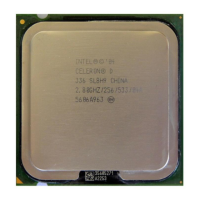Acoustic Fan Speed Control
R
56 Thermal/Mechanical Design Guide
Figure 18. Fan Speed Control
Diode Temperature
(°C)
T
CONTROL
Min Speed
Fan Speed
(RPM)
Full Speed
T
LOW
X %
Fan Speed
(% PWM Duty Cycle)
100 %
Diode Temperature
(°C)
T
CONTROL
Min Speed
Fan Speed
(RPM)
Full Speed
T
LOW
X %
Fan Speed
(% PWM Duty Cycle)
100 %
6.3.1.1 Temperature to begin Fan Acceleration
The first item to consider is the value for T
LOW
. The FSC device needs a minimum temperature to
set as the threshold to begin increasing PWM duty cycle to the fan.
The system designer might initially consider a small temperature range
(T
CONTROL
– T
LOW
= T
RANGE
), such as 5 °C to accelerate the fan. That would delay the fan
accelerating for the longest period after an increase in T
DIODE
. There are a number of issues that
should be considered with this strategy:
• There is little granularity in the fan speeds. For each 1 °C of increase in diode
temperature = 20% jump in PWM duty cycle %.
• Fan speed oscillation as the thermal solution chases the diode temperature.
• Having T
DIODE
overshoot T
CONTROL
and the thermal profile causing the Thermal Control
Circuit to activate to reduce the temperature.
The first two cases can create a poor acoustic response for the user. For the third case, the user
could notice a drop in performance as the thermal control circuit reduces the power.
Figure 19 is
an example of this situation. The system begins at idle and a moderate workload is applied (less
than TDP).

